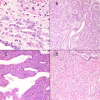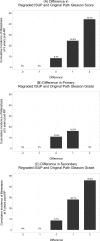Clinical Validation of the 2005 ISUP Gleason Grading System in a Cohort of Intermediate and High Risk Men Undergoing Radical Prostatectomy
- PMID: 26731672
- PMCID: PMC4712132
- DOI: 10.1371/journal.pone.0146189
Clinical Validation of the 2005 ISUP Gleason Grading System in a Cohort of Intermediate and High Risk Men Undergoing Radical Prostatectomy
Abstract
In 2005, the International Society of Urological Pathology (ISUP) introduced several modifications to the original Gleason system that were intended to enhance the prognostic power of Gleason score (GS). The objective of this study was to clinically validate the 2005 ISUP Gleason grading system for its ability to detect metastasis. We queried our institutional RP database for men with NCCN clinically localized intermediate to high-risk disease undergoing radical prostatectomy (RP) between 1992 and 2010 with no additional treatment until the time of metastatic progression. A case-cohort design was utilized. A total of 333 available RP samples were re-reviewed and GS was reassigned per the 2005 ISUP Gleason system. Cumulative incidence of metastasis was 0%, 8.4%, 24.5% and 44.4% among specimens that were downgraded, unchanged, had one point GS increase and two point GS increase, respectively. The hazard ratio for metastasis raised in GS 8 and 9 compared to GS 7 from 2.77 and 5.91 to 3.49 and 9.31, respectively. The survival c-index of GS increased from 0.70 to 0.80 when samples were re-graded at 5 years post RP. The c-index of the reassigned GS was higher than the original GS (0.77 vs 0.64) for predicting PCSM at 10 years post RP. The regraded GS improved the prediction of metastasis and PCSM. This validates the updated Gleason grading system using an unambiguous clinical endpoint and highlights the need for reassignment of Gleason grading according to 2005 ISUP system when considering comparisons of novel biomarkers to clinicopathological variables in archival cohorts.
Conflict of interest statement
Figures





Similar articles
-
The impact of the 2005 International Society of Urological Pathology consensus guidelines on Gleason grading - a matched-pair analysis.BJU Int. 2016 Jun;117(6):883-9. doi: 10.1111/bju.13439. Epub 2016 Feb 22. BJU Int. 2016. PMID: 26823232
-
Gleason score 3 + 4=7 prostate cancer with minimal quantity of gleason pattern 4 on needle biopsy is associated with low-risk tumor in radical prostatectomy specimen.Am J Surg Pathol. 2014 Aug;38(8):1096-101. doi: 10.1097/PAS.0000000000000235. Am J Surg Pathol. 2014. PMID: 24832163
-
Accuracy of prostate biopsies for predicting Gleason score in radical prostatectomy specimens: nationwide trends 2000-2012.BJU Int. 2017 Jan;119(1):50-56. doi: 10.1111/bju.13458. Epub 2016 Mar 24. BJU Int. 2017. PMID: 26918298
-
The impact of the 2005 international society of urological pathology consensus conference on standard Gleason grading of prostatic carcinoma in needle biopsies.J Urol. 2008 Aug;180(2):548-52; discussion 552-3. doi: 10.1016/j.juro.2008.04.018. Epub 2008 Jun 11. J Urol. 2008. PMID: 18550106
-
From Gleason to International Society of Urological Pathology (ISUP) grading of prostate cancer.Scand J Urol. 2016 Oct;50(5):325-9. doi: 10.1080/21681805.2016.1201858. Epub 2016 Jul 14. Scand J Urol. 2016. PMID: 27415753 Review.
Cited by
-
Transcriptomes of Prostate Cancer with TMPRSS2:ERG and Other ETS Fusions.Mol Cancer Res. 2023 Jan 3;21(1):14-23. doi: 10.1158/1541-7786.MCR-22-0446. Mol Cancer Res. 2023. PMID: 36125519 Free PMC article.
-
Transfer Learning with Pretrained Convolutional Neural Network for Automated Gleason Grading of Prostate Cancer Tissue Microarrays.J Med Signals Sens. 2024 Feb 14;14:4. doi: 10.4103/jmss.jmss_42_22. eCollection 2024. J Med Signals Sens. 2024. PMID: 38510670 Free PMC article.
-
High mortality risk of prostate cancer patients in Asia and West Africa: A systematic review.Avicenna J Med. 2020 Jul 3;10(3):93-101. doi: 10.4103/ajm.ajm_19_20. eCollection 2020 Jul-Sep. Avicenna J Med. 2020. PMID: 32832424 Free PMC article. Review.
-
Automating Prostate Cancer Grading: A Novel Deep Learning Framework for Automatic Prostate Cancer Grade Assessment using Classification and Segmentation.J Imaging Inform Med. 2025 Feb 6. doi: 10.1007/s10278-025-01429-2. Online ahead of print. J Imaging Inform Med. 2025. PMID: 39913023
-
Predicting prostate cancer specific-mortality with artificial intelligence-based Gleason grading.Commun Med (Lond). 2021 Jun 30;1:10. doi: 10.1038/s43856-021-00005-3. eCollection 2021. Commun Med (Lond). 2021. PMID: 35602201 Free PMC article.
References
-
- Epstein JI, Egevad L, Humphrey PA, Montironi R, Diagnostic II. Best Practices Recommendations in the Application of Immunohistochemistry in the Prostate Report From the International Society of Urologic Pathology Consensus Conference. American Journal of Surgical Pathology. 2014;38(8):E6–E19. 10.1097/PAS.0000000000000238 - DOI - PubMed
Publication types
MeSH terms
LinkOut - more resources
Full Text Sources
Other Literature Sources
Medical

